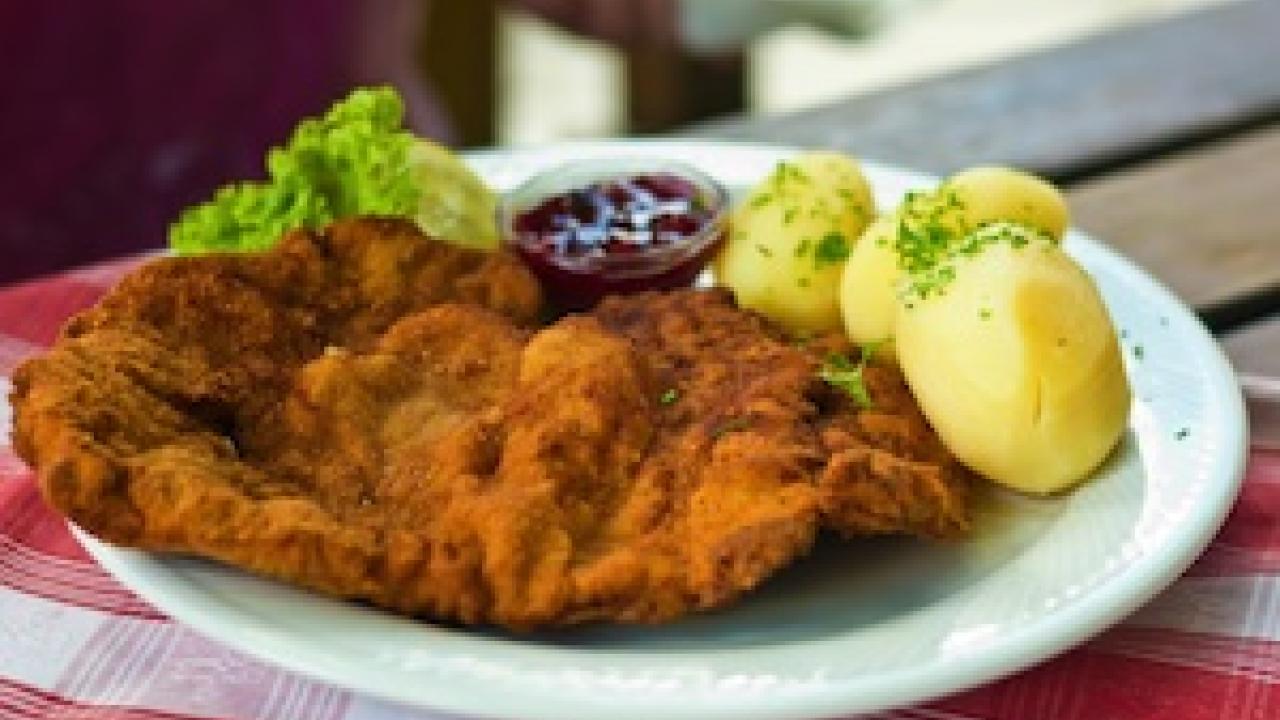How to prepare Wiener Schnitzel on your own!
A hero on the plate: The Viennese Schnitzel
Although it‛s a rather hearty dish, it still got a subtle touch and can be enjoyed in most restaurants in the city. The Schnitzel is a typical piece of Vienna which is as traditional as fashionable.
When breadcrums meet some meat
The name “Wiener Schnitzel” was formed in the beginning of the 20th Century, although there have been several ancestors of the baked cutlet. For the first time it has been mentioned in a cookbook, which has been dated to the year 1831. In 1884 it is even described in a Bohemian cookbook. Katharina Prato who is still famous for her cookbooks, which are featuring Southern German and Austrian dishes, described the Wiener Schnitzel in a book from 1907. She called it „eingebröselte Kalbsschnitze‟. This means something like „breadcrum veal cutlet‟ and is definitely no name for fame. The name „Wiener Schnitzel‟ for the breaded veal cutlets got common around 1908. But even before the Schnitzel captured the Austrian pans, there were various dishes which consisted of breading something and baking it in a mass of hot butter. A culinary highlight of this kind is the Backhendl (baked chicken) which appeared in a cookbook in 1719.
A cutlet? A legend!
All successful things in the world are rich in legends. Therefore there are a lot of stories about the Wiener Schnitzel. Allegedly Field Marshal Radetzky brought the recipe from Italy in 1857. In the years 1848 to 1849, he served as general commander of the Austrian army in the region of Lombardy-Venetia and put the Italian revolution down. During his stay in Italy he might have tried the Costoletta alla milanese which had some tradition over there. Radetzky was so excited about this court that he mentioned it in a military report to the emperor’s palace. After his return the imperial cook was asked to prepare the Costoletta alla milanese. He certainly did. And it was so tasty that it soon spread throughout the empire. For this dish, however, no chop was used, but pieces of juicy back lobe. And instead of white bradcrumbs they used crispy, brown breadcrumbs. Soon the „Wiener Schnitzel‟ was offered in many restaurants.
True or legend?
This legend of the Wiener Schnitzel is probably justified in political tensions between Austria and Italy. The Radetzky-brings-the-Schnitzel-theory has been refuted in 1967 by anthropologist Günter Wiegelmann in his book about everyday and solid foods in Central Europe. The historian Richard Zahnhausen (2001) and the linguist Heinz Dieter Pohl (2007) confirmed Wiegelmanns point of view: The story about the Italian origin of the Wiener Schnitzel is invented and probably goes back to a restaurant guide from the year 1971. Furthermore, the Vienne Cuisine already knew of fat-baked dishes before the lifetime of Radetzky. No other cuisine baked more than the Viennese. So they definitely didn‛t need any milanese input on that kind of food.
A traditional dish with a dash of glamour
The Wiener Schnitzel started it‛s career as a feast. From the mid-19th Century it was the dish for special occassions for all sorts of people. In the 1960s the traditional dish got such a great reputation that even Napoleon III and his wife Eugénie had “Côte de veau à la Lette viennoise” for lunch. No surprise that they called it Kaiserschnitzel (Kaiser means imperator) as well. Some cooks started to use the cheaper pork instead of veal. The original Wiener Schnitzel was served on occasions like New Year, weddings and Christmas in most households. It replaced the roast which was usual on festive days before. At a wedding dinner, which included various courses, the Wiener Schnitzel was a popular intermediate course or midnight snack. Many decades later, the Schnitzel typically served on Sundays in Austria. You will find it on every menu of every restaurant that wants to offer good home-style cooking. Because of its finesse and popularity, the Wiener Schnitzel is also present in expensive restaurants and chic bistros. In 1901 a popular cookbook said that the Schnitzel should be served in all restaurants – no exeptions. And many of them still respect this very Austrian rule.
A Schnitzel is a Schnitzel. Or not.
There are loads of restaurants and pubs in Vienna that offer Wiener Schnitzel, for the court has always played an important role in the local cuisine. So watch out if you don‛t know what exactly makes a Schnitzel a Schnitzel! You could be taken in. Traditionally the Schnitzel consists of the best parts of veal (ask if they use Kalbsnuss, Kaiserteil or Frikandeau). The veal gets breaded with freshly grated rolls (Kaisersemmeln) and baked in butter, lard or oil. After that beauty treatment the coat of breadcrumbs (Panier) appears golden brown and crispy. The question of sidedish is a question of taste: Usually they serve lettuce, potato salad, cucumber salad or cooked potatoes with butter and parsley. French fries or baked potatoes are common variations. Some say it‛s all about the lemon that you drip over the Schnitzel. This slightly sour touch has tradition: It was used to conceal the taste of old lard or bad meat. But don‛t dread the lemon. These days it‛s just used to add some flavour.
The best choice for the best veal
It‛s not as simple as it may seem. Chefs call the preparation of a good Schnitzel the royal discipline. However, since the Schnitzel is a national treasure, you can choose from a range of good restaurants. The rather simple restaurant Heuriger Weiss (Geigeringasse 2) is good value. In the stylish but comfortable Rochus (Landstraßer Hauptstraße 55) gays, lesbians and heteros meet and eat. In the centre of the gay and lesbian quarter you find the trendy bistros Motto (Schönbrunner Str. 30) and Schon Schön (Lindengasse 53). Join the in-crowd dining in a really cool atmosphere. The probably best choice for Wiener Schnitzel is the legendary restaurant Figlmüller (Wollzeile 5). Figlmüller is known as the home of the Schnitzel. Besides it‛s very cozy and very Austrian. Who‛s there? Young people, old people, gays, lesbians, foreigners, Austrians and transsexuals. And Schnitzels. Not cheap but worth the money.
Receipe
Ingredients
four escalopes of around 120 grams each
To apply the Breadcrumbs:
flour, 2 eggs, breadcrumbs, salt / pepper, oil or lard for frying
Preparation
The escalopes will need to be pounded until the meat is around a 1/4 of an inch thick. Make sure to trim the edges of the meat carefully. Lightly season the escalopes with salt and pepper. You will need three shallow bowls - 1 for the eggs, 1 for flour and 1 for breadcrubs. Dip the escalopes in the flour first, then in the whisked egg and then in the breadcrumbs. Be careful to ensure that the entire escalope is completely covered with the breadcrumbs. Place the escalopes in a hot frying pan, the oil in the pan should be deep enough that the schnitzel’s float whilst cooking. Cooking time should not be more than 4 minutes for each side. Serve hot with a slice of fresh lemon!


